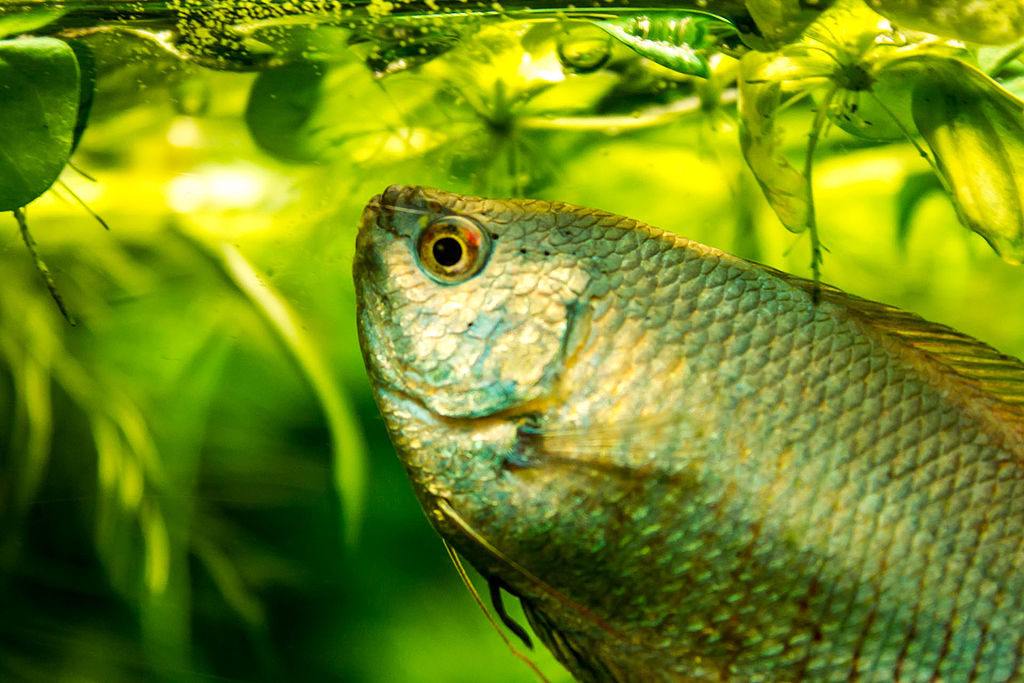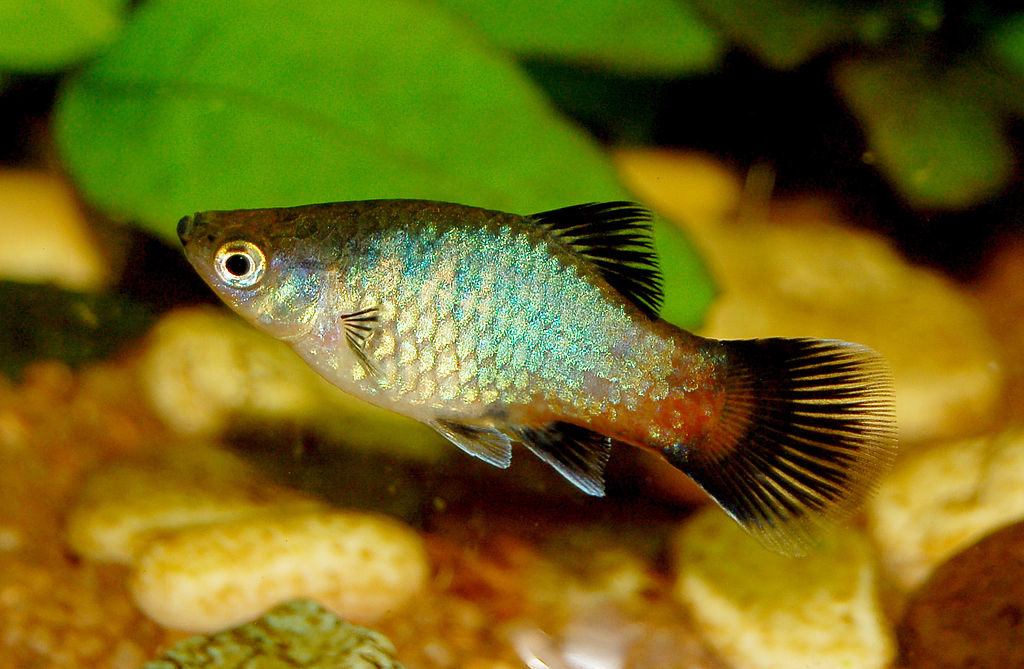Thinking about keeping fish, but don’t know where to start? The platy fish might be just what you’re looking for!
Platys are part of the genus Xiphophorus, though unlike most of their cousins in the freshwater kingdom, they lack the sword-like fins on the undersides of their tails.

Like both mollies and guppies, the platy is a ‘live bearer,’ meaning that the female platy keeps her eggs and incubates them from within for the duration of her pregnancy, in the end giving birth to live, free-swimming baby platy fish! How awesome is that?
Luckily, unlike some of their slightly more aggressive cousins in the pond, platy fish are naturally peace-loving, so you won’t have to worry about having too many around.
Let’s not get ahead of ourselves, though. Before you start worrying about caring for a pregnant platy, let’s go over some of the very basics you’ll need to know to master your platy fish care.
After all, a strong understanding of your hardy little fish will set you up for years of success with these lovable little guys!
Contents
First things first – Get to Know Your Platy Fish!
Platy Fish Appearance
A platy fish lifespan ranges anywhere from two to three years, though some have been known to live longer.
They are a hardy, friendly breed of freshwater fish native to Central America and the southern tip of Mexico.
Years ago, there were two breeds of this types – the southern platy fish and the variatus platy – but these days, most pet stores carry a hybrid of the two, and even the keenest fish owner would have a hard time telling the two breeds apart.
To make things harder on the discerning eye, both breeds of platy fish will grow to a maximum size of 7.0 centimeters (2.8 inches) and all breeds come in a wide variety of colors that all have their own distinct names!

There’s everything from ‘salt and pepper’ to ‘wagtail,’ ‘tuxedo’ to ‘rainbow’, and all sorts of mixtures in between that can range from blue, red, black, brown, and even some solid golds!
The only thing simpler to tell amongst the platy fish is their gender; not only are female platys a bit larger, but they have a distinctive shape to their anal fins (called gonopodiums, for the trivia-lover).
Females have a rounded, fan-like fin on the underside near their tails, while the male platy boasts a sword-shaped fin instead.
Platy Fish Care
Tank Requirements
Generally speaking, you should have a tank that is at least ten gallons. Some websites and fish specialists claim that five gallons will do for a single fish; and, technically speaking, they aren’t wrong.
However, if you want to keep more than a single platy fish in your tank (and how could you not? These colorful little guys want some companions like any other self-respecting freshwater vertebrate!), you’ll want to keep a tank that is at the very least ten gallons.
On top of being sociable and friendly, platy fish are known to be very active and spend a lot of time moving around, so they and any other schools of fish you have in your tank need plenty of room to do so.
As for your aquarium’s specifics, make sure to do your research.
Water Requirements
As a general rule for a basic set-up, your freshwater aquarium should have:
- Temperature: Anywhere between 72 and 82 degrees Fahrenheit.
- pH: between 6.5 and 7.5.
- No ammonia (0 ppm).
- No nitrites (0 ppm).
- Nitrates at less than 40 ppm.
- Alkalinity (kH): Between 4 and 8 dKH (or 71.6 to 143.2 ppm).
- Water Hardness (GH): Between 4 and 12 dGH (71.6 to 214.2 ppm).
However, you’ll want to keep in mind that platy fish have their own preferences, which are a little more specific in some places but thankfully within the parameters of all freshwater tanks, such as:
- Temperature: Anywhere between 68 and 78.8 degrees Fahrenheit, a little towards the top of the spectrum given their warm origins.
- pH: Between 7 and 8.3, meaning they prefer a little more alkalinity in their environment.
- No ammonia (0 ppm).
- No nitrites (0 ppm).
- Nitrates at less than 40 ppm.
- Alkalinity (kH): Between 4 and 8 dKH (or 71.6 to 143.2 ppm).
- Water Hardness (GH): Between 12 and 18 dGH (214.29 to 321.43 ppm), which is one of the reasons they’re considered such a resilient fish for first-time owners.

Tank Maintenance
Make sure that if you don’t know how to keep track of, or adjust, any of these specific needs, you talk with your local fish expert on the matter.
The alkalinity, hardness, pH, and temperature in your tank are cause for many sad fish if they’re not kept track of. Luckily, however, it isn’t all that difficult to do once you’ve got it down and have the equipment reporting for you.
Because of these specific parameters, though, it’s important that you keep your aquarium clean…but not too clean!
As a rule of thumb, you only want to replace about 25 percent of the water at any given time, as replacing more can not only drastically change the chemistry in your tank, but it can also shock your fish both emotionally and physically.
Being scared right to death is an unfortunate and common experience among the finned community!
Make sure you ask your pet store associates lots of questions and try to only buy from knowledgeable and reputable pet or fish stores.
Platy Fish Food
You have your school of platy fish, a great tank set-up, and now they’re all staring at you longingly through the glass. What on earth should you feed them? Well, thankfully, this is a simple one!
In the wild, platy fish are omnivorous and enjoy anything from plants, to algae, to insects, and even small crustaceans like brine shrimp.
At home in your aquarium, they’ll thrive on fish flakes and a fresh or frozen variety of their preferred proteins, such as blackworms, bloodworms, daphnia, fruit flies, and mosquito larvae (though such larvae is usually illegal to culture in most areas).

The only thing you should be wary of, if you intend to give your platys a full and thriving lifestyle, is the ingredients in their commercially-produced flake food.
As a rule of thumb, try to keep away from main ingredients like grain or rice, and instead look for any source of protein (such as fish or worms) at the top of the ingredients list.
Following just that one simple guideline can ensure many happy years with the same healthy school of fish you started with.
That being said, make sure you’re either keeping your platys in a very large tank or that you keep an eye on any shenanigans between your male and female platys, as they are extremely prolific fish.
If their tank is too small to support a new generation of fry (baby fish, that is!), you might catch them eating each other to thin things out.
While that might be a “fintastic” source of protein, it may also traumatize a young owner.
On that note: What to Expect When You Suddenly Have Fifty More Platy Fish!
Platy Fish Tankmates
Platy fish care requires some basic understanding about who’s going to be sharing a tank with them. At the very least, it’s worth mentioning that you don’t want to keep just one platy fish all by its lonesome in the tank.
The platy fish is a very social, community-loving animal, so while one may survive on its own, if you want your platy fish to thrive, consider at least two, three, or even more platys in one tank.
Luckily, if you find yourself wanting to keep other fish, but don’t want to break out a new tank set-up, platies are considered to be one of the most peaceful freshwater fish out there.
They will do well with many other species such as mollies, swordtails, tetras, danios, angelfish, and even bigger tetras such as the Silver Tipped Tetra or the Black Skirt Tetra.

If you find yourself keeping swordtails and platies in the same tank, though, keep in mind that they can cross-breed with one another. You may end up with a whole new breed in your tank!
So, you’ve got their social norms down, how about that AQUARIUM?
Offspring
It happens to us all. You buy a few platy fish, and suddenly you’ve got more platies than you can handle – or that your tank can hold! So, what to do?
Well, first, you might avoid this problem altogether by just buying one gender of platy fish for your entire tank.
With their easily discernible gonopodiums (that fin on the underside of their bellies), it shouldn’t be too difficult to pick out either all females or all males for your new school.
Be careful of buying any fat-looking platies though, as that could be an indication that she is already pregnant, and as they take five weeks to gestate, you may not know until you have a tank full of fry!
However, if you are trying to increase the number of platies in your school, keep to the three-to-one ratio. That is, one male to every three female platy fish. Even if you only start out with four fish, you’ll have numerous platies in no time!
If you can separate a pregnant platy from the rest of your school, you should move her to a separate tank to have her fry before placing her back in the community tank.
This, aside from assuring you can keep an eye on the new platies, will also ensure they reach maturity without becoming someone’s snack!
Here’s a video explaining more details on the platy fish.
Final Thoughts on the Colorful Platy Fish
All in all, the platy fish is a great pet to own whether you’re a beginner or an experienced fish parent.
With the right tank, the right friends, and the right food, platies can be considered some of the easiest fish to keep, and will give any fish hobbyist hours of entertainment.
The next time you come across these simple fishies in your local pet store, why not try to pick out the leader of the school, or the males and females in the group? You might just find yourself falling in love with the friendliest fish in the pond.


I found your care and feeding of the platy article very interesting and informative. Simple and to the point but fun to read. Thank you very much.